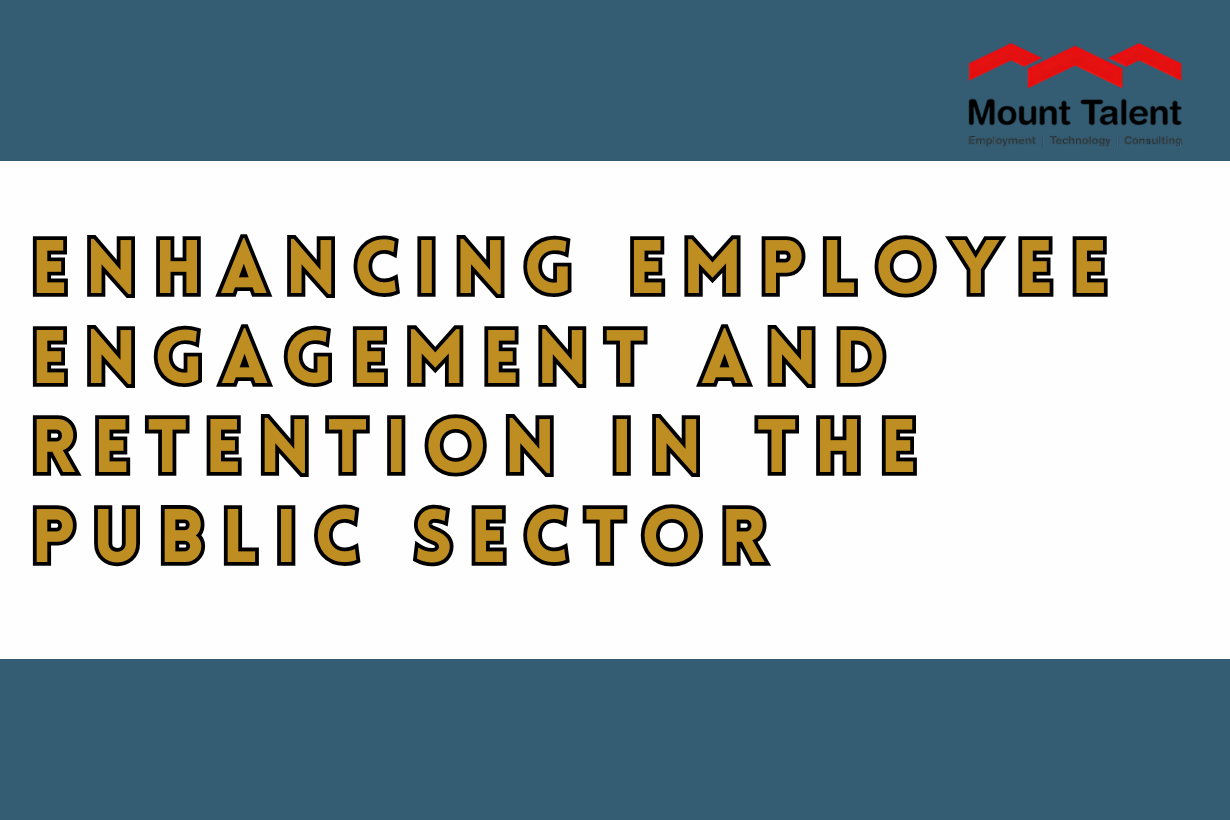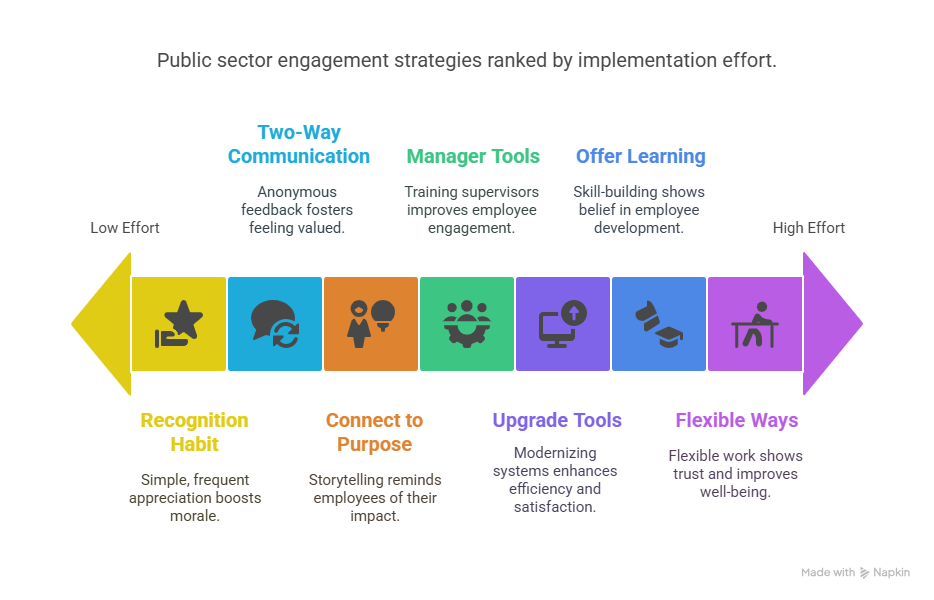
Enhancing Employee Engagement and Retention in the Public Sector
- by Indu Sharma
When we think of the public sector, the words that often come to mind are stability, structure, and service. For decades, government jobs have been seen as reliable, long-term career choices. But in today’s fast-changing world of work, being stable isn’t always enough to keep employees motivated and committed.
Employees, especially younger ones, are looking for more: a sense of purpose, professional growth, and a workplace that truly values their contributions. This shift has made public sector employee engagement strategies more important than ever. If employees aren’t engaged, they’re more likely to disengage emotionally, be less productive, or leave altogether.
At Mount Talent Consulting, we work with government and public organizations to bring in a fresh, people-first approach. Let’s explore how we can build a more connected, motivated, and loyal workforce in the public sector.
Why Engagement Is the Foundation of Retention
Engagement isn’t just about job satisfaction, it’s about how invested people feel in their work. Are they proud of what they do? Do they believe in the organization’s goals? Do they feel their voice matters?
In sectors like healthcare, education, and public administration, employees are already doing work that has a real societal impact. But that alone isn’t always enough. Without ongoing support, feedback, recognition, and opportunities to grow, even the most purpose-driven employees can become disengaged.
What’s Holding Back Engagement in Public Organizations?
Let’s be honest public institutions often face some unique challenges when it comes to keeping their employees engaged:
1- Bureaucracy and rigid rules: These can limit creativity and decision-making at all levels.
2- Slow career advancement: Promotions and raises are often based on tenure, not performance.
3- Limited feedback and recognition: A no news is good news culture doesn’t help anyone feel seen or appreciated.
4- Technology gaps: Outdated tools can make work more frustrating than it needs to be.
5- Lack of flexibility: Strict work hours or office-only policies can feel out of step with today’s needs.
6- But here’s the good news: These aren’t permanent problems. With the right mindset and support, public sector leaders can create an environment where employees feel engaged, respected, and ready to contribute their best.
What’s Working: Smart Engagement Strategies for the Public Sector

Based on our experience and what’s worked across both public and private settings, here are some strategies that can make a big difference:
-
Help Employees Connect to Purpose
Many people join the public sector because they want to make a difference. But over time, red tape and routine can dull that spark. Use storytelling, team huddles, or newsletters to highlight how teams are helping communities. That reminder can reignite pride in the work they do.
-
Offer More Learning, Not Just Training
Traditional one-time training isn’t enough anymore. Offer short courses, cross-department learning, peer mentorship, and opportunities to attend webinars or workshops. Even small steps in skill-building can send a strong signal: We believe in your growth.
-
Create Space for Two-Way Communication
Instead of only top-down updates, build ways for employees to share their feedback through anonymous surveys, open Q&A sessions with leaders, or suggestion boxes that actually get reviewed. When people feel heard, they feel valued.
-
Make Recognition a Habit, Not a Ceremony
You don’t need a big budget for appreciation. A simple email shoutout, a handwritten note, or highlighting someone’s contribution during a team meeting can boost morale instantly. Make recognition part of your culture.
-
Explore More Flexible Ways of Working
Not every public sector role allows remote work, but flexibility isn’t just about location. It could mean staggered hours, compressed workweeks, or even rotating tasks to break monotony. Flexibility shows trust and improves well-being.
-
Upgrade Tools to Make Work Easier
Clunky software and paper-heavy processes don’t just slow things down, they frustrate employees. Modernizing systems, even gradually, can improve efficiency and make work more rewarding.
-
Give Managers the Right Tools to Lead
Often, it’s not policies but managers that shape how engaged someone feels. Train supervisors in people management—how to have regular check-ins, give feedback, and support mental well-being. The ripple effect is real.
What Can the Public Sector Learn from the Private Sector?
There’s no need to copy the private sector, but there’s no harm in borrowing ideas that work. Employee engagement in the private sector tends to focus more on personalization, agility, and innovation. Here’s what public institutions can adapt:
– More frequent feedback instead of annual reviews
– Performance-based recognition, even non-monetary
– Tailored career growth paths based on interest and skills
– Leadership visibility leaders who connect regularly with their teams
– More investment in employee well-being, both mental and physical
With some creativity and flexibility, many of these practices can be adapted to the public sector context.
Retention Follows Engagement
If your employees feel disconnected or unappreciated, no amount of job security will keep them long-term. On the other hand, if they feel energized by their work, connected to their teams, and supported in their goals, they’ll stick around even when they have other options.
Retention doesn’t require sweeping reforms. It starts with small, consistent actions that say, you matter here.
Conclusion
At Mount Talent Consulting, we’ve seen firsthand how small changes can make a big impact. We partner with public sector organizations to co-create engagement models that are realistic, inclusive, and aligned with real employee needs.
We believe that the future of public service depends on the people who deliver it and when those people feel valued, everything else improves too.
Frequently Asked Questions
Q1. Why is employee engagement so important in the public sector?
Because these roles often directly serve the public, disengagement can affect not just internal operations but also citizen experiences and trust in the system.
Q2. How is engagement in the public sector different from the private sector?
Public institutions often face more rules and slower change. But they also offer purpose-driven roles—something that, when nurtured, can be a huge engagement driver.
Q3. What’s one affordable way to improve engagement right now?
Start with recognition. A consistent habit of appreciating efforts verbally, through emails, or even peer shoutouts can shift morale quickly.
Q4. Can public sector roles be flexible too?
Yes! Flexibility isn’t only about working from home. It can be about scheduling, job rotation, or creative task-sharing, all of which improve work-life balance.
When we think of the public sector, the words that often come to mind are stability, structure, and service. For…
